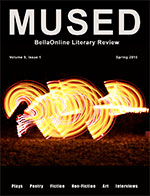Pump House, Installation Art by Michael McMillan, Palm Springs Art Museum
R.D. Hartwell
On my excursion to the Palm Springs Art Museum several years ago, perhaps my twelfth visit, I encountered the installation art created by Michael McMillan entitled “The Pump House, or the Manifesto of the Crooked Branch.” Encountered is too soft a word; I was overwhelmed by this work of art. I am having trouble removing its image from my mind’s eye and I need to share my feelings with others.
The docent for the group I was with, Frank Guido, told us that we were going to have to take a short trip to view “The Pump House.” He informed us that we would have to grope our way through a short, darkened tunnel, walking on gravel, in order to see what he called an installation artwork. We traversed a rock-strewn pathway, negotiated two short corridors created by intersecting walls, and did this in semidarkness. Our ears became our guides as the rocks crunched and gave beneath our feet. It was as if we had been navigating across some desolate plain and then came upon this outpost of marginal civilization. We came through a doorway and upon not only the pump house, but into the light and into the sound.
Other than with music, I had never previously considered sound as part of an art form; how wrong I was! Mr. McMillan’s creation, “The Pump House,” creates not only a visual impact, but an auditory one as well. There is the rhythmic pitch and thrust of the pump itself, the periodic rocking of the “horse” atop the shaft. There is the drone of the television inside the house, playing so low that only the realization of noise remains and not the actual meanings of words. And there is the surge and splash and gurgle of water as it is lifted from with the bowels of the earth and spilled into the catch basin next to the pump house. So much of the impact of “The Pump House” relies on the intersection of sight and sound; the rhythms of media white noise, mechanical regularity and precision, and the natural refreshment of working, moving water, all commingle as counterpoint to the austerity and bleakness of the pump house itself.
The visual blandness, bleakness really, of the pump house is emphasized by the refuse left around the outside: rusted pipes and fittings, piles of discarded parts, broken boards. The exterior of the house is papered in newsprint. The television has been left on. Everywhere there are visual reminders of the trespass of man on the desert environment. Everywhere are reminders of the fleeting passage of the lives of men in a stark environment. Yet, above it all, there is hope; HOPE is spelled out in capital letters on the roof of the pump house; hope is exemplified by the life-giving water continuously welling up from below; hope is personified in the intersection of the rhythms of both man and nature.
Michael McMillan has subtitled his work, “. . . or the Manifesto of the Crooked Branch.” As I understand it, manifesto means a public declaration of meaning or intent, in this case presumably the artist’s. Crooked Branch could possibly refer to the underwater aquifer from which the pump house draws water; however, a more likely possibility is a reference to the tree of life and the crooked and bent nature of man’s use and abuse of the natural environment.
This installation artwork makes one think, think deeply, almost as deeply as the natural water being drawn from the earth by the rhythmic actions of the pump. Some viewers may not enjoy this clash of man and machine and nature, but I do and I think the artist has captured the emotions inherent in this struggle. Life may, indeed, be a crooked branch or path; however, as a guiding principle, there is always hope above; perhaps in a religious sense, perhaps merely in the acknowledgment that the earth will abide, regardless of the transitory nature of man. As a manifesto to this belief, Michael McMillan’s artwork, “The Pump House,” works for me.

